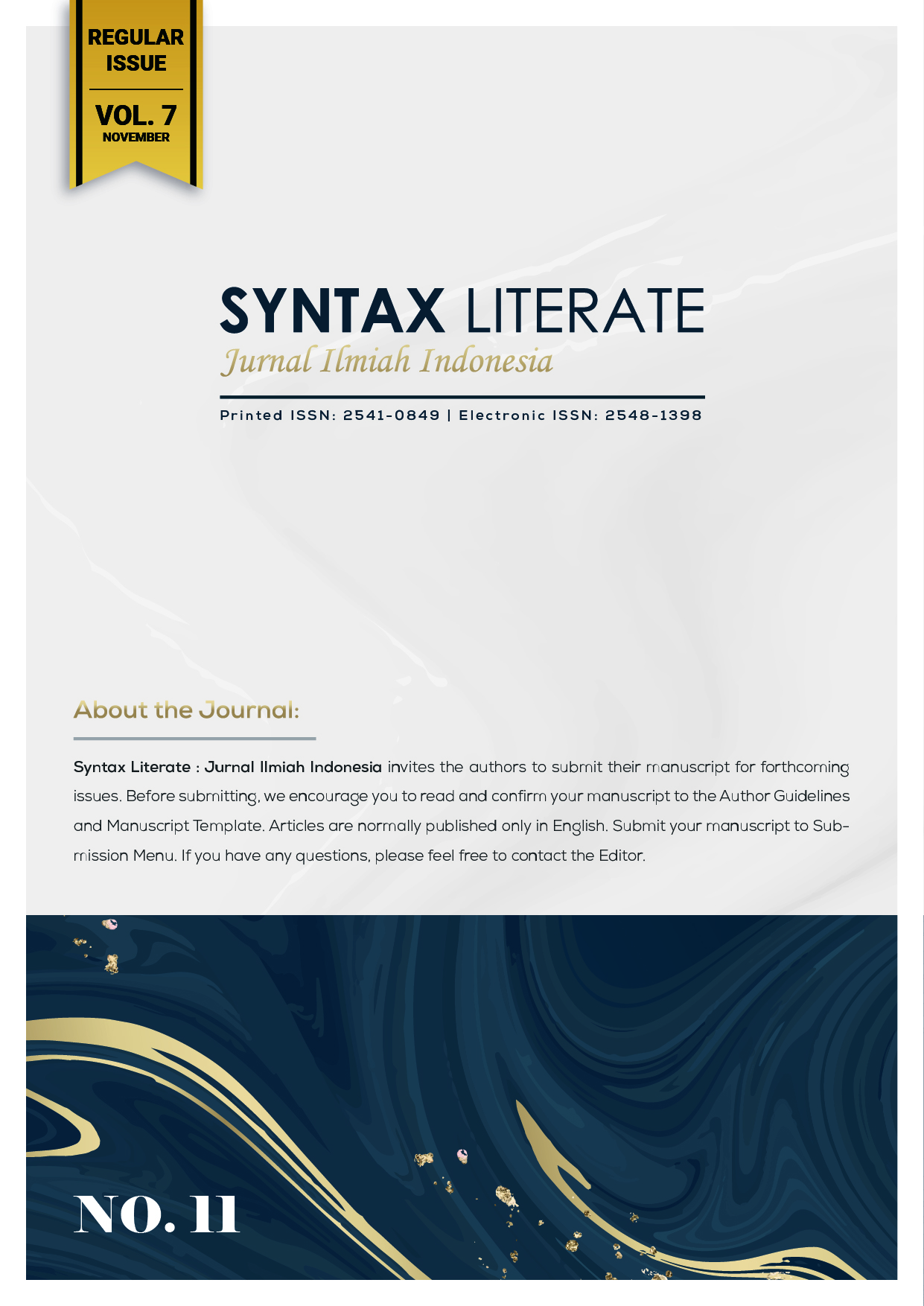Moderating Role of Mobile Payment Technology That Influence Intention to Use of Mobile Payment in Indonesia
Abstract
Penelitian ini bertujuan untuk menyelidiki peran moderasi teknologi pembayaran seluler dalam mempengaruhi niat penggunaan pembayaran seluler di Indonesia. Mengingat adopsi teknologi pembayaran seluler yang semakin meningkat di Indonesia, penelitian ini bertujuan untuk memahami bagaimana faktor-faktor tertentu dapat mempengaruhi niat individu untuk menggunakan pembayaran seluler, dengan teknologi pembayaran seluler sebagai variabel moderator. Metode penelitian ini menggunakan pendekatan kuantitatif dengan menggunakan survei online. Sampel penelitian terdiri dari individu pengguna pembayaran seluler di Indonesia. Instrumen survei yang digunakan mencakup skala pengukuran untuk mengukur variabel niat penggunaan pembayaran seluler, faktor-faktor yang mempengaruhi niat, dan teknologi pembayaran seluler sebagai variabel moderator. Hasil analisis data menunjukkan bahwa teknologi pembayaran seluler memiliki peran moderasi yang signifikan dalam mempengaruhi hubungan antara faktor-faktor yang mempengaruhi niat penggunaan pembayaran seluler di Indonesia. Hasil ini memberikan pemahaman yang lebih baik tentang bagaimana penggunaan teknologi pembayaran seluler dapat memperkuat atau melemahkan pengaruh faktor-faktor lain terhadap niat penggunaan pembayaran seluler. Penelitian ini memiliki implikasi penting bagi industri pembayaran seluler di Indonesia. Hasil penelitian ini dapat membantu perusahaan dan penyedia layanan pembayaran seluler untuk memahami faktor-faktor yang mempengaruhi niat penggunaan dan mengoptimalkan penggunaan teknologi pembayaran seluler untuk meningkatkan adopsi dan kepuasan pengguna.
Downloads
References
Al-Saedi, K., Al-Emran, M., Ramayah, T., & Abusham, E. (2020). Developing a general extended UTAUT model for M-payment adoption. Technology in Society, 62(September 2019), 101293. https://doi.org/10.1016/j.techsoc.2020.101293
Annisa, D. (2021, October). https://covid19.kemkes.go.id.
Bougie, R., & Sekaran, U. (2020). Research Methods for Business A Skill-Building Approach (8 ed.). New Jersey: John Wiley & Sons, Inc.
Chauhan, S. (2015). Acceptance of mobile money by poor citizens of India : Integrating trust into the technology acceptance model. info, 17, 58-68.
Chuttur, M. (2009). Overview of the Technology Acceptance Model : Origins, Developments and Future Directions. Sprouts : Working Papers on Information Systems, 9-37.
de Luna, I. R., Liébana-Cabanillas, F., Sánchez-Fernández, J., & Muñoz-Leiva, F. (2019). Mobile payment is not all the same: The adoption of mobile payment systems depending on the technology applied. Technological Forecasting and Social Change, 146(August), 931–944. https://doi.org/10.1016/j.techfore.2018.09.018
Flavián, C., & GuinalÃu, M. (2006). Consumer trust, perceived security and privacy policy: Three basic elements of loyalty to a web site. Industrial Management & Data Systems, 106(5), 601–620. https://doi.org/10.1108/02635570610666403
Hair, J. F., Jr, Hult, G. T. M., Ringle, C., & Sarstedt, M. (2016). A Primer on Partial Least Squares Structural Equation Modeling (PLS-SEM).
Heuvel, S. van den. (2020). COVID-19 beats current technology acceptance theories.
Hsu, M., & C.M., C. (2004). Internet self efficacy and electronic service acceptance. Decision Support Systems, 38, 369-381. doi:10.1016/j.dss.2003.08.001
BI. (2020) Ini sederet kebijakan BI mendorong transaksi digital di tengah pandemi corona.
iPrice. (2020, August 19). marketinginasia.com.
Flavián, C., & GuinalÃu, M. (2006). Consumer trust, perceived security and privacy policy: Three basic elements of loyalty to a web site. Industrial Management & Data Systems, 106(5), 601–620. https://doi.org/10.1108/02635570610666403
Kalinic, Z., Marinkovic, V., Molinillo, S., & Liébana-Cabanillas, F. (2019). A multi-analytical approach to peer-to-peer mobile payment acceptance prediction. Journal of Retailing and Consumer Services, 49(March), 143–153. https://doi.org/10.1016/j.jretconser.2019.03.016
Kim, K., & D., S. (2015). An acceptance model for smart watches: implications for the adoption of future wearable technology. Internet research, 25, 527-541. doi:10.1108/intr-05-2014-0126
King, W., & He, J. (2006). A meta-analysis of the technology acceptance model. Inf-Manag, 43, 740-755.
Li, J., Wang, J., Wangh, S., & Zhou, Y. (2019). Mobile Payment with Alipay: An Application of Extended Technology Acceptance Model. IEEE Access, 7(May 2017), 50380–50387. https://doi.org/10.1109/ACCESS.2019.2902905
Lin, S-P. (2011) ‘Determinants of adoption of mobile healthcare service’, International Journal of Mobile Communications,Vol. 9, No. 3, pp.298–315
Liebana-Cabanillas, F., de Luna, I. R., & Montoro-Rios, F. (2017). Intention to use new mobile payment systems : A comparative analysis of SMS and NFC payments. Economic research - Ekonomska Istrazivanja, 30, 892-910. doi:http://dx.doi.org/10.1080/1331677X.2017.1305784
Liébana-Cabanillas, F., Japutra, A., Molinillo, S., Singh, N., & Sinha, N. (2020). Assessment of mobile technology use in the emerging market: Analyzing intention to use m-payment services in India. Telecommunications Policy, 44(9). https://doi.org/10.1016/j.telpol.2020.102009
Marangunic, N., & Granic, A. (2014). Technology Acceptance Model : a literature review from 1986 to 2013. Univ Access Inf Soc, 14, 81-95. doi:10.1007/s10209-014-0348-1
Pal, A., Herath, T., De', R., & Rao, H. (2020). Contextual facilitators and barriers influencing the continued use of mobile payment services in a developing country : Insight from adopters in India. Information Technology for Development. doi:10.1080/02681102.2019.1701969
Park, J., Amendah, E., Lee, Y., & Hyun, H. (2018). M-payment service: Interplay of perceived risk, benefit,. Hum. Factors Man, 1-13. doi:10.1002/hfm.20750
Phonthanukitithaworn, C., Selitto, C., & W.L Fong, M. (2016). A Comparative Study of Current & Potential User of Mobile Payment Services. SAGE Open, 1-4. doi:10.1177/2158244016675397
Pratama, A. M. (2021, February 9). Kompas.com.
PricewaterhouseCoopers. (2019). Global Consumer Insight 2019. PWC
Shah, M. H., Peikari, H. R., & Yasin, N. M. (2014). The determinants of individuals’ perceived e-security: Evidence from Malaysia. International Journal of Information Management, 34(1), 48–57. https://doi.org/10.1016/j.ijinfomgt.2013.10.001
Ting, H., Yacob, Y., Liew, L. & Lau, W.M. (2016). Intention to Use Mobile Payment System: A Case of Developing Market by Ethnicity. Hiram Ting et al. / Procedia - Social and Behavioral Sciences,224, 368 – 375: https://doi.org/10.1016/j.sbspro.2016.05.390
Verma, P., & Sinha, N. (2017, January). Role of attitude as mediator of the perceived ease of use and behaviour intention relationship. International Journal Management Concepts and Philosophy, 10, 227-245. doi:10.1504/IJMCP.2017.085831
Yan, L. Y., Tan, G. W. H., Loh, X. M., Hew, J. J., & Ooi, K. B. (2021). QR code and mobile payment: The disruptive forces in retail. Journal of Retailing and Consumer Services, 58(May 2020). https://doi.org/10.1016/j.jretconser.2020.102300
Yang, H., & Yoo, Y. (2003). It's all about attitude: Revisiting the technology acceptance model. Decision Support Systems, 38, 19-31.
Copyright (c) 2022 Atika Febrianti, Noris Subekti, Wahyu Aji

This work is licensed under a Creative Commons Attribution-ShareAlike 4.0 International License.











